2022 felt like the year that floorstanding loudspeakers fell into two very distinct camps; mid-tier products under $2,000 that deliver a lot of performance for the money, and really expensive models that require comparable electronics that can really show off their capabilities. The second category isn’t really our focus anymore because we’re trying to cap our system recommendations at $20,000 USD on the music listening side. Writing about $30,000 loudspeakers doesn’t move the needle at all — not in terms of what readers care about and where the industry focus needs to be if it wants to grow the base. With the exception of the Dynaudio Focus 50, all of my picks are below $2,000 USD.
Wireless loudspeakers took a huge step forward in 2022, but predominantly in the bookshelf category which makes sense because most consumers don’t have the budget or space for floorstanding loudspeakers.
Selecting the Focus 50 was rather easy after three listening sessions in 2022; it offers everything you might need in two loudspeaker cabinets, room correction software, and better sound quality than a number of more expensive systems with a pair of loudspeakers and multiple components and sets of cables.
Don’t get me wrong — $11,000 USD is a lot of money for a pair of loudspeakers, but it’s not a lot of money for a complete high-end system in 2022.
I was so impressed with the Danish loudspeakers, that I’m leaning towards replacing one of my main systems with them in 2023 and using one of my existing turntables and phono stages to finish it all up. The sound quality was actually superior and who needs so much complexity and that awful maze of cables.
On the other end of the spectrum, there are some excellent, affordable high-end floorstanding loudspeakers available now and that excites me because they are actually attainable. And that’s what high-end audio needs to be for a much larger group of consumers.
Acoustic Energy AE320

I know it’s odd for me to say that the brand new Acoustic Energy AE320 loudspeakers are underrated, but my experience with the brand here in North America would suggest that the audio/video press isn’t really all that excited about it.
Reviews from across the pond are aplenty, but I don’t recall reading too many reviews of their products in domestic publications and my review of the Acoustic Energy AE1 is pretty rare. Tarun from “A British Audiophile” had a similar listening experience with his review pair and we discussed it during our recent YouTube broadcast.
The AE1 was so good that I actually fought the distributor to let me listen to them for another month but they were the only demo pair and I looked back twice at the boxes as the nice lady at FedEx standing behind the 3″ of glass during the pandemic put them on the belt and they disappeared behind the wall.
The bigger point is that Acoustic Energy offers three tiers of loudspeakers that offer rather exceptional performance for far less than other brands and I would include Spendor, Harbeth, ProAc, KEF, Paradigm, and Q Acoustics on that list.
The brand new Acoustic Energy AE320 definitely benefit from more power even with their generous 90 dB sensitivity rating. Tube amplifiers work really well with the Acoustic Energy speakers but they definitely work well Naim, Arcam, NAD, and Rotel.
I would also steer clear of amplification that is too neutral sounding. The 100 Series speakers have a warmer tonal balance than their more expensive siblings but that changes with the 300 Series and its aluminum tweeter.
So avoid Acoustic Energy at your peril but trust me when I say that these speakers have flown under the radar in North America for far too long. The new importer, Fidelity Imports, is going to change that in a big way.
The AE320 is a true, 3-way slim-line floor-standing loudspeaker with compact dimensions and suitable for medium to large sized rooms. The AE320 uses three latest generation 130mm drivers, one mid-range and two bass only units.
The new Acoustic Energy AE320 is available in high gloss Piano Black or White and Real Walnut wood veneer cabinet finishes from authorized retailers from October 2021. UK SRP per pair is from £1,599 / $1,990.
Pros: Solid build quality, transparency, detailed, quick, excellent value for the money
Cons: Treble can be a tad bright if you stick with neutral amplification, need some space to really show off what they can do
For more information: Acoustic Energy 300 Series
Focal Chora 816

Focal created this line to produce high-fidelity sound, offering the performance and modern industrial design of their more expensive loudspeakers — in much more affordable price range.
We loved the Focal Chora 806 bookshelf loudspeakers which you can read about here.
The Chora range features the brand new Slatefiber cone. Developed and manufactured in Focal’s workshops in France, it distinguishes itself by a dynamic, detailed and balanced sound.
The Slatefiber cones are lighter, faster, and have better damping than the Polyglass woofers of the previous Chorus speakers; the Chora 816 have proven to be adept with electronic, jazz, and even large scale symphonic works.
The satin-finish wood-grain veneer looks very sleek (Black, Dark Wood, Light Wood) and Focal gets top marks for front baffles that visually compliment the choice of veneers. The Blue-Gray front baffle on the Dark Wood (walnut) version makes them the focal point of any room where they are set-up.
Focal built its reputation with its Beryllium tweeters; it is one of the most expensive materials to work with and the “house” sound that has entranced a lot of customers and members of the press over the years has focused on that aspect of the designs.
Because of the cost, the Chora line-up utilizes a 1” Aluminum/Magnesium inverted dome tweeter instead and my ears tell me that it was a wise choice.
The Chora 816 are rated at 89 dB (8 ohms) which is rather efficient for a bookshelf loudspeaker, but they do dip down to 5 ohms so I would take the sensitivity rating with the knowledge that they do benefit from some power.
Pros: Warm tonal balance, detail, midrange resolution, bass impact, excellent with both music and movies
Cons: Need some power, slightly dark tonal balance, need some space from walls to not overload small rooms
Where to buy: $998/pair at Crutchfield
Q Acoustics 3050i

The 3050i does not get enough respect from the hi-fi press and that’s problematic because it offers so much value for the money. The build quality is quite high for the price and they do feel rather substantial when you set them up. The feet can be somewhat wobbly on carpet and I would stick with a hardwood floor if you can.
Ditch the foam port pucks that are designed to be inserted if the loudspeaker has to be placed closer to the wall due to space limitations. I have my 3050i set up in my dining room along the long wall and there is only 8″ between the wall and the rear of the cabinet.
They sound more open and spacious without the pucks and the low end impact is more than enough in a room that is 16′ x 13′ x 9′ with two openings into the living room and kitchen.
The 3050i have a rather polite presentation unless you drive them with the right amplifier and they can become almost boring if the rest of the system doesn’t have some top end energy and the midrange is fleshed out.
Pros: Easy to drive, strong bass, can be placed near walls, flexible for home theater use, excellent with vocals
Cons: Treble can be rather polite, foam pucks muddy the bass, slightly unstable base needs better feet
Where to buy: $999/pair at Amazon | qacoustics.com
Magnepan LRS

There are a million opinions online about the topic but the simple truth is that you can drive a loudspeaker like the Magnepan LRS (Little Ribbon Speaker) with any amplifier that can double its output and is stable into a 4 ohm load. A/V receivers are not great choices in this scenario. Their actual power output into a 4 ohm load is rather iffy.
Emotiva, NAD (not the C 316BEE V2), Schiit Audio, Bryston, Audio Research, and Pass Labs all work well with Magnepan.
The LRS need a lot of space. A minimum of 3 feet from the wall behind them. You also need to angle the panels so that the tweeter potion of the panel are further from your ears than the woofer. I have my LRS turned so that the woofer panel is almost 2 inches closer to my listening position.
The LRS also benefit from either a heavy paving stone placed underneath the legs or a dedicated stand like the Magna Risers.
Don’t expect a lot of deep bass from the LRS – that’s not why you are buying it.
Pros: Transparency, detail, clarity, deep soundstage, very immediate presentation, superb value for the money
Cons: Limited bass, require high current amplification, wonky feet, need to be placed at least 3 feet from the wall behind them
Where to buy: Magnepan Dealer Locator
Wharfedale Diamond 12.3

Wharfedale’s founder, Gilbert Briggs built his first loudspeaker in 1932 in his home in Ilkey, Yorkshire; the town was based in the valley of the river “Wharfe.” Briggs opened Wharfedale Wireless Works in 1933 supplying advanced loudspeaker drivers to the growing radio industry and the company became a leading supplier selling more than 9,000 units per year until the outbreak of World War II.
The company flourished after the war and became one of the first companies to offer a two-way loudspeaker in 1945 – the prototype for the modern loudspeaker.
The Diamond series has been around for a number of years and have always offered a lot of performance for the money. A pair of Wharfedale Diamond 10.1shave graced my home office for almost 6 years and I have zero desire to replace them; they work incredibly well with both solid state and tubes.
The Diamond 12.3s utilize two 5″ Klarity midrange woofers and one 1″ soft dome tweeter in a rather inert enclosure that blends really well in modern and traditional settings.
The 88 dB (8 ohms, dips to 5 ohms) sensitivity makes them rather easy to drive and they certainly love amplifiers like the Audiolab 6000A and NAD C 316BEE V2Integrated Amplifiers.
The Diamond 12.3s deliver strong dynamics, detail, and a very high level of resolution. They don’t need to be pulled that far from the walls to really deliver balanced performance.
The build quality is superb for the money.
Pros: Balanced, airy treble, punchy mid bass and upper midrange, excellent with vocals, superb value for the money
Cons: Need better quality electronics to really shine, slightly reserved presentation, vinyl veneer
Where to buy: $998/pair at Crutchfield

Dynaudio Focus 50 ($11,000)
$11,000 for a floorstanding wireless loudspeaker? Please show the same degree of indignation and incredulity when someone mentions $5,000 interconnects and $80,000 turntables and we can have lunch together.
The Focus 50 offers everything but a turntable and it’s not hard to understand why some audiophiles would ditch everything except for their digital and analog sources and enjoy the rest of the audio journey with this magnificent loudspeaker from Dynaudio.
You can connect the Roon Ready Focus 50 loudspeakers to your network via WiFi or Ethernet and the system also supports Bluetooth, Apple AirPlay, Google Chromecast, Tidal Connect, Spotify Connect, and Internet Radio — which is pretty much every possible streaming platform you will ever need. Qobuz is supported via Roon (or via Bluetooth) if you roll that way.
The primary speaker has two sets of analog inputs, and 3 digital inputs (1 Toslink, 2 Coaxial), along with a single subwoofer output.
The 72 pound cabinets offer that understated Danish flair that I inherently love and while the Focus 50 are rather large loudspeakers, they also come with Dirac Live built into the package and control app.
Why does that matter? Dirac Live does an impressive job of room correction in listening spaces that may not want to cooperate fully. This would be one of the first high-end wireless speakers to offer this package and it means that the Focus 50 can be tailored to work in any room (for the most part) even if you move into a different home and your listening space changes rather dramatically.
Pros: Bold, dynamic, and detailed presentation, build quality, Dirac Live, replaces an entire high-end system in two loudspeaker cabinets
Cons: Expensive, does not include an internal phono preamplifier
Related Reading:





















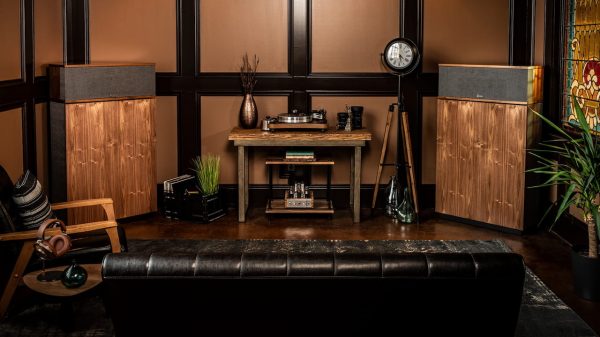
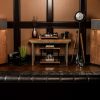
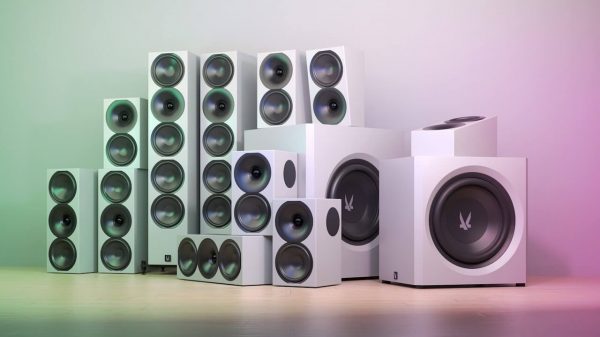
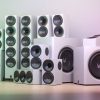
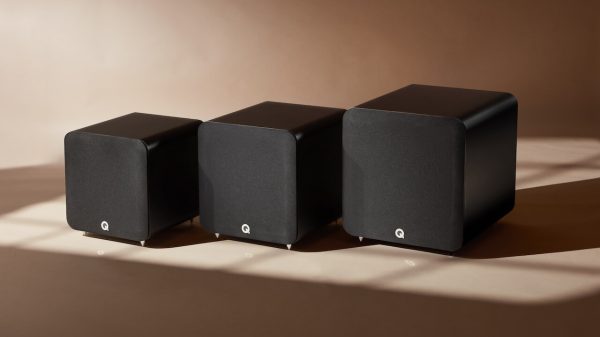
















Catherine Lugg
December 11, 2022 at 4:35 pm
Thanks so much for focusing on equipment retirees can afford. I’m looking longingly at both the Whardedale Diamond 12.3 AND the Q Acoustics 3050i. I already own the 3030is and really love them to pieces. Both look like outstanding buys. I’ll have to flip a quarter to sort things out. Again, thanks so much.
Ian White
December 11, 2022 at 10:17 pm
Catherine,
I’m doubling down in 2023 on the “affordable” stuff. I’m about to start paying for a second kid in college and my brain is looking for high-end pieces that people can afford. As a heads up — reviews and features about affordable products get 5x the number of reads even if the $$$$ component is from a very established brand.
Both of those speakers are really solid investments. The 3050i is more temperamental; how does one explain the $1,700 Schiit Ragnarok 2 that I own being outclassed by the NAD C 316BEE V2 which is almost $1,000 less.
Best,
Ian White
B. Wilensky
December 12, 2022 at 3:31 am
I auditioned the Chora 826 and the Revel Concerta 2 F36. I liked both, but the detail and smoothness of the Revel absolutely amazed me. And this is from a former audio regional sales manager (now retired) who bought at retail!
Ian White
December 12, 2022 at 2:31 pm
Both excellent speakers. I can see liking the Revel, which I have not listened to in many years. Their products have always impressed me.
Best,
Ian White
Step
December 12, 2022 at 11:27 pm
Wharfedale was sold off in the late 1950s, the current manufacturing site is in Ji’an in China
Ian White
December 13, 2022 at 12:12 am
IAG has done a really good job with the company.
Best,
Ian White